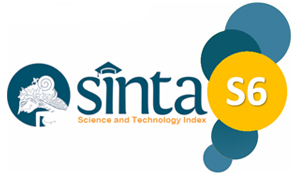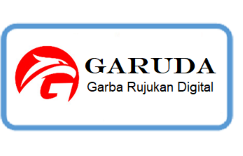PENGUKURAN KEMIRIPAN TUGAS POKOK DAN FUNGSI SEKRETARIAT DINAS PENDIDIKAN KOTA DI JAWA TIMUR MENGGUNAKAN AHP
DOI:
https://doi.org/10.30587/indexia.v5i02.6747Abstract
Permasalahan yang akan diatasi dalam penelitian ini adalah kebutuhan akan pengaturan standar tugas pokok dan fungsi (tupoksi) untuk sekretariat Dinas Pendidikan Kota di Jawa Timur. Metode penelitian melibatkan pengumpulan data tupoksi sekretariat dari berbagai kota, dilanjutkan dengan analisis semantik dilakukan menggunakan algoritma PATH dengan alat bantu WS4J. Penggunaan WS4J untuk menilai kesamaan nilai hanya terbatas pada hubungan antar kata-kata. Maka, penyesuaian dilakukan menggunakan metode Analytical Hierarchy Process (AHP) untuk menentukan nilai relatif atau bobot. Dalam AHP, terdapat dua faktor yang menjadi kriteria penentuan bobot, yaitu kategori kata benda dan kata kerja. Hasil akhir penelitian ini berupa common fragment tupoksi sekretariat dari berbagai Dinas Pendidikan Kota di Jawa Timur. Common fragment ini nantinya dapat digunakan sebagai dasar standar yang konsisten, yang akan membantu mengatasi berbagai permasalahan yang muncul akibat tupoksi tidak terstandarisasi.
References
[2] F. Abdullah, “Measuring service quality in higher education: HEdPERF versus SERVPERF,” Mark. Intell. Plan., vol. 24, no. 1, pp. 31–47, Jan. 2006, doi: 10.1108/02634500610641543.
[3] F. Abdullah, “The development of HEdPERF: a new measuring instrument of service quality for the higher education sector,” Int. J. Consum. Stud., vol. 30, no. 6, pp. 569–581, Nov. 2006, doi: 10.1111/j.1470-6431.2005.00480.x.
[4] G. P. Barnhill, E. A. Polloway, and B. M. Sumutka, “A Survey of Personnel Preparation Practices in Autism Spectrum Disorders,” Focus Autism Dev. Disabil., vol. 26, no. 2, pp. 75–86, Jun. 2011, doi: 10.1177/1088357610378292.
[5] A. Saepudin, C. Sukmana, J. S. Ardiwinata, and N. Kamarubiani, “Analysis of Non Formal Education Human Resources in Sup-port of Service and Quality Equality Education Programs in Sumedang Regency,” J. Nonform. Educ., vol. 8, no. 2, pp. 192–199, Aug. 2022, doi: 10.15294/jne.v8i2.36439.
[6] J. Zhang and T. Qi, “Construction of Educational Resource Metadata Management Platform Based on Service-Oriented Architecture,” J. Sens., vol. 2022, pp. 1–10, Jun. 2022, doi: 10.1155/2022/2172817.
[7] M. A. Halwani, S. Y. Amirkiaee, N. Evangelopoulos, and V. Prybutok, “Job qualifications study for data science and big data professions,” Inf. Technol. People, vol. 35, no. 2, pp. 510–525, Mar. 2022, doi: 10.1108/ITP-04-2020-0201.
[8] S. Guo, F. Alamudun, and T. Hammond, “RésuMatcher: A personalized résumé-job matching system,” Expert Syst. Appl., vol. 60, pp. 169–182, Oct. 2016, doi: 10.1016/j.eswa.2016.04.013.
[9] W. Shalaby et al., “Help me find a job: A graph-based approach for job recommendation at scale,” in 2017 IEEE International Conference on Big Data (Big Data), Boston, MA: IEEE, Dec. 2017, pp. 1544–1553. doi: 10.1109/BigData.2017.8258088.
[10] A. L. Paoletti, J. Martinez-Gil, and K.-D. Schewe, “Extending Knowledge-Based Profile Matching in the Human Resources Domain,” in Database and Expert Systems Applications, vol. 9262, Q. Chen, A. Hameurlain, F. Toumani, R. Wagner, and H. Decker, Eds., in Lecture Notes in Computer Science, vol. 9262. , Cham: Springer International Publishing, 2015, pp. 21–35. doi: 10.1007/978-3-319-22852-5_3.
[11] A. B. Kmail, M. Maree, and M. Belkhatir, “MatchingSem: Online recruitment system based on multiple semantic resources,” in 2015 12th International Conference on Fuzzy Systems and Knowledge Discovery (FSKD), Zhangjiajie, China: IEEE, Aug. 2015, pp. 2654–2659. doi: 10.1109/FSKD.2015.7382376.
[12] O. S. Vaidya and S. Kumar, “Analytic hierarchy process: An overview of applications,” Eur. J. Oper. Res., vol. 169, no. 1, pp. 1–29, Feb. 2006, doi: 10.1016/j.ejor.2004.04.028.
[13] Y. Li, D. McLean, Z. A. Bandar, J. D. O’Shea, and K. Crockett, “Sentence similarity based on semantic nets and corpus statistics,” IEEE Trans. Knowl. Data Eng., vol. 18, no. 8, pp. 1138–1150, Aug. 2006, doi: 10.1109/TKDE.2006.130.
[14] T. Kajiwara, D. Bollegala, Y. Yoshida, and K. Kawarabayashi, “An iterative approach for the global estimation of sentence similarity,” PLOS ONE, vol. 12, no. 9, p. e0180885, Sep. 2017, doi: 10.1371/journal.pone.0180885.
[15] L. Xu, J. Guo, and H. Huang, “A Sentence Similarity Computation for Restricted Domain,” DEStech Trans. Comput. Sci. Eng., no. mso, Apr. 2018, doi: 10.12783/dtcse/mso2018/20487.
[16] W. Wali, B. Gargouri, and A. Ben Hamadou, “Enhancing the sentence similarity measure by semantic and syntactico-semantic knowledge,” Vietnam J. Comput. Sci., vol. 4, no. 1, pp. 51–60, Feb. 2017, doi: 10.1007/s40595-016-0080-2.
[17] M. C. Lee, J. W. Chang, and T. C. Hsieh, “A Grammar-Based Semantic Similarity Algorithm for Natural Language Sentences,” Sci. World J., vol. 2014, pp. 1–17, 2014, doi: 10.1155/2014/437162.
[18] G. U. Abriani and M. A. Yaqin, “Implementasi Metode Semantic Similarity untuk Pengukuran Kemiripan Makna antar Kalimat,” Ilk. J. Comput. Sci. Appl. Inform., vol. 1, no. 2, pp. 47–57, Dec. 2019, doi: 10.28926/ilkomnika.v1i2.15.
[19] Y. Shen, S. Zhang, H. S. Wong, and L. Zhang, “Characterisation of semantic similarity on gene ontology based on a shortest path approach,” Int. J. Data Min. Bioinforma., vol. 10, no. 1, p. 33, 2014, doi: 10.1504/IJDMB.2014.062887.
[20] P. Resnik, “Semantic Similarity in a Taxonomy: An Information-Based Measure and its Application to Problems of Ambiguity in Natural Language,” J. Artif. Intell. Res., vol. 11, pp. 95–130, Jul. 1999, doi: 10.1613/jair.514.
[21] J. Flisar and V. Podgorelec, “Identification of Self-Admitted Technical Debt Using Enhanced Feature Selection Based on Word Embedding,” IEEE Access, vol. 7, pp. 106475–106494, 2019, doi: 10.1109/ACCESS.2019.2933318.
[22] R. Weegar, K. Åström, and P. Nugues, “Linking Entities Across Images and Text,” in Proceedings of the Nineteenth Conference on Computational Natural Language Learning, Beijing, China: Association for Computational Linguistics, 2015, pp. 185–193. doi: 10.18653/v1/K15-1019.
[23] EEDIS Laboratory, Djillali Liabes University of Sidi Bel Abbes, Sidi Bel Abbes, 22000, Algeria, S. S. Ahmed, M. Malki, and S. M. Benslimane, “Ontology Partitioning: Clustering Based Approach,” Int. J. Inf. Technol. Comput. Sci., vol. 7, no. 6, pp. 1–11, May 2015, doi: 10.5815/ijitcs.2015.06.01.
[24] T. Slimani, “Description and Evaluation of Semantic Similarity Measures Approaches,” Int. J. Comput. Appl., vol. 80, no. 10, pp. 25–33, Oct. 2013, doi: 10.5120/13897-1851.
[25] M. Farouk and Department of Thermotechnik Computer Science, Assiut University, Markaz El-Fath, Assiut Governorate 71515,Egypt;, “Measuring Sentences Similarity: A Survey,” Indian J. Sci. Technol., vol. 12, no. 25, pp. 1–11, Jul. 2019, doi: 10.17485/ijst/2019/v12i25/143977.
[26] X. Wen, “Chinese Sentence Semantic Matching With Multi-Granularity Based on Siamese Neural Network,” presented at the The 33rd International Conference on Software Engineering and Knowledge Engineering, Jul. 2021, pp. 586–591. doi: 10.18293/SEKE2021-074.
[27] Y. Yoo, T.-S. Heo, Y. Park, and K. Kim, “A Novel Hybrid Methodology of Measuring Sentence Similarity,” Symmetry, vol. 13, no. 8, p. 1442, Aug. 2021, doi: 10.3390/sym13081442.



 Template INDEXIA
Template INDEXIA



